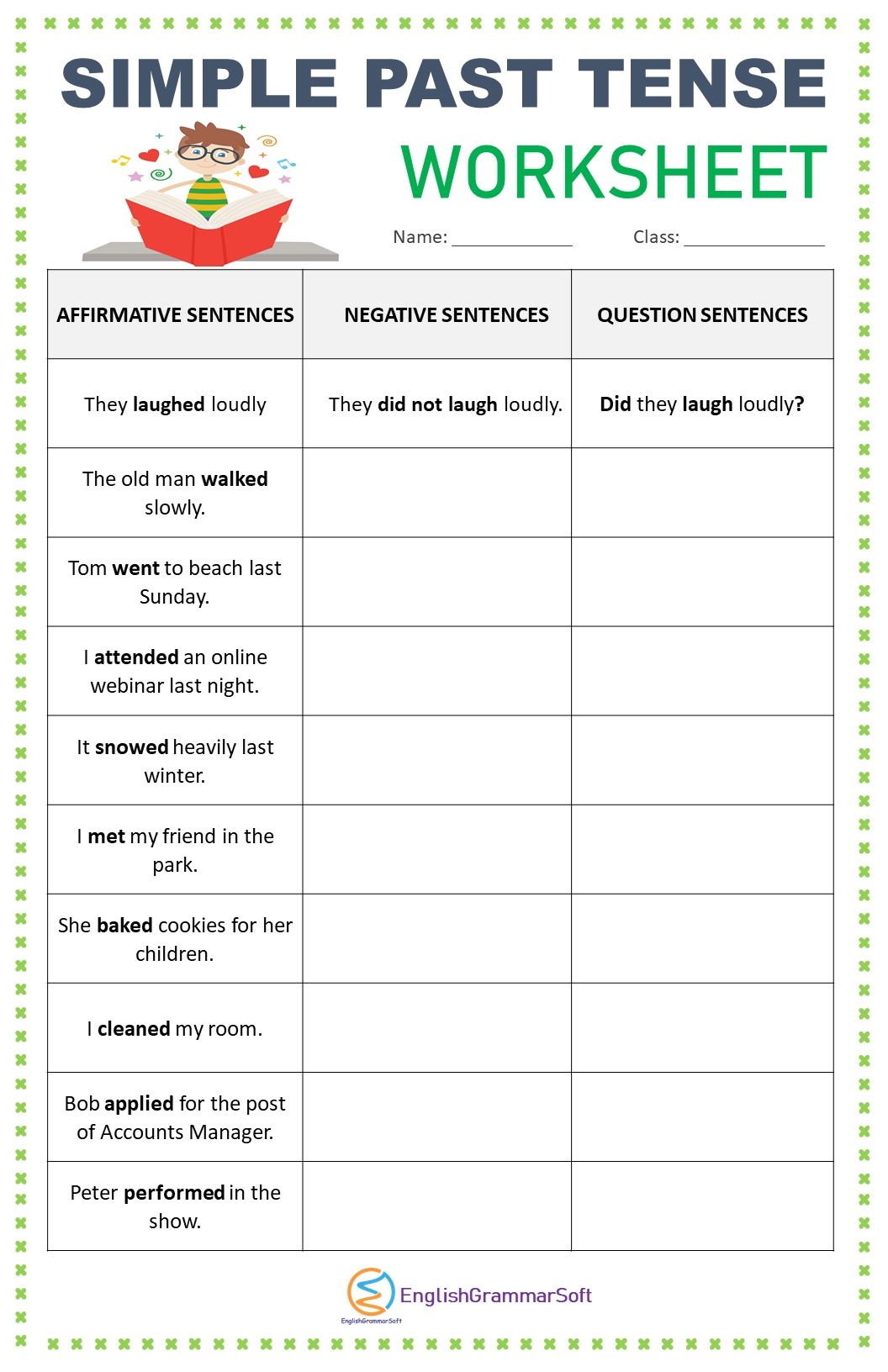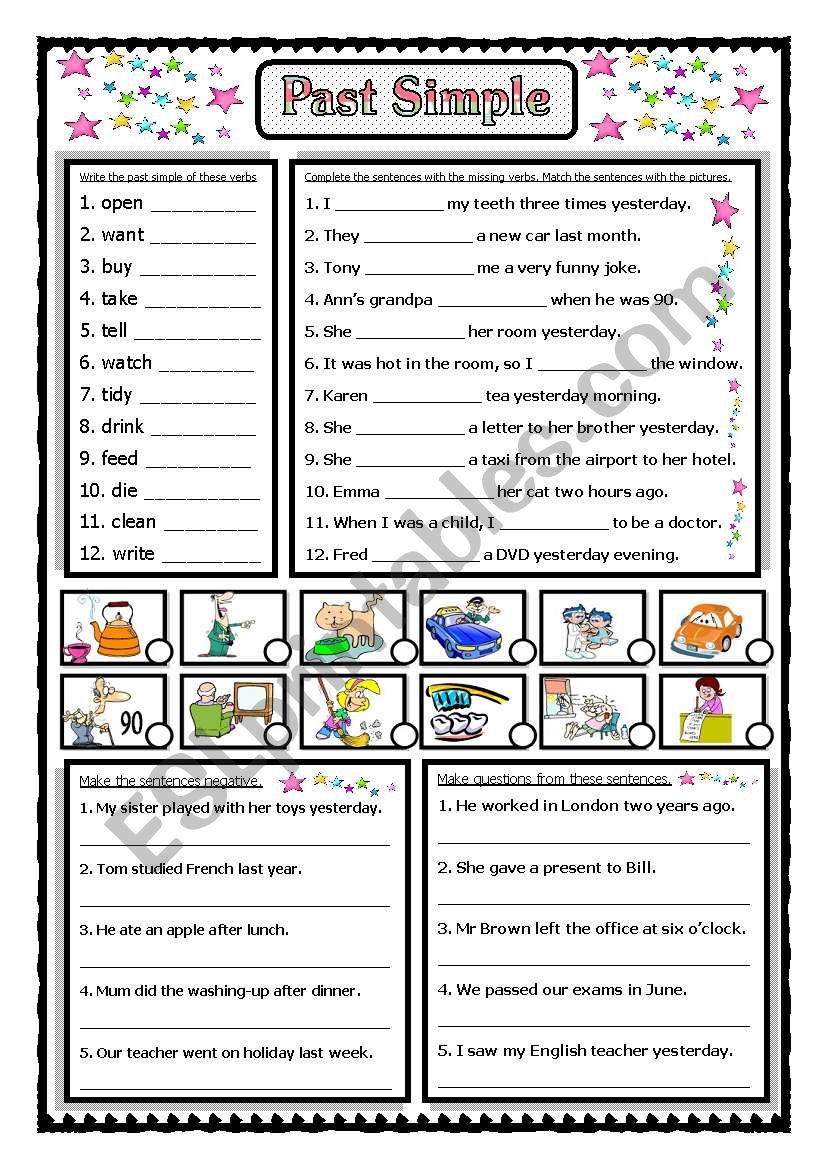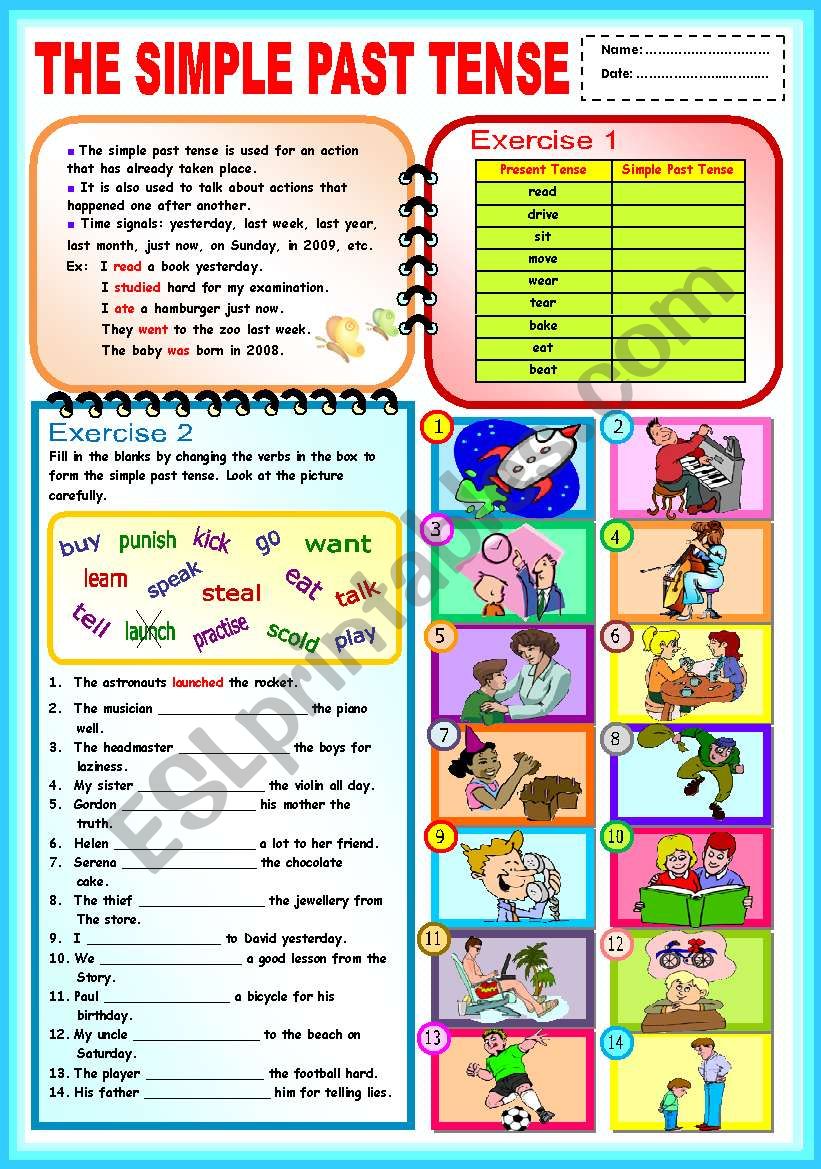
Mastering the Past: The Indispensable Role of Past Simple Worksheets
The ability to talk about the past is fundamental to human communication. Whether recounting a personal experience, narrating a historical event, or simply describing yesterday’s activities, the Past Simple tense stands as a cornerstone of English grammar. It’s often one of the first tenses learners encounter after the present, yet its nuances – particularly with irregular verbs and the formation of negatives and questions – can present significant hurdles. This is where well-designed and strategically utilized Past Simple worksheets become an invaluable tool in the language learning arsenal. Far from being mundane drills, these targeted exercises offer a structured, repetitive, and often engaging pathway to mastery.
Why the Past Simple is So Crucial
Before delving into the specifics of worksheets, it’s essential to appreciate the pervasive nature of the Past Simple. It’s used for:

- Completed Actions in the Past: "I visited Paris last summer."
- Series of Completed Actions: "She woke up, ate breakfast, and went to work."
- Past Habits or Routines: "When I was a child, I played outside every day." (Often with "used to," but Past Simple works too).
- Past Facts or Generalizations: "The Roman Empire was vast."




Without a solid grasp of this tense, learners are severely limited in their ability to engage in meaningful conversations, understand narratives, or express themselves coherently about anything that has already occurred. Common errors include using the base form of the verb after "did/didn’t," struggling with the correct past form of irregular verbs, or confusing the Past Simple with other past tenses like the Present Perfect or Past Continuous. These challenges highlight the need for consistent, focused practice that Past Simple worksheets are perfectly poised to provide.
The General Benefits of Worksheets in Language Learning
Worksheets, in general, offer a range of pedagogical advantages:

- Reinforcement and Practice: They provide the necessary repetition for new concepts to solidify.
- Structured Learning: They break down complex grammar points into manageable, bite-sized exercises.
- Self-Paced Learning: Learners can work at their own speed, focusing on areas where they need more help.
- Diagnostic Tools: Teachers can quickly identify common errors and areas of weakness.
- Variety of Exercise Types: From simple fill-in-the-blanks to more complex sentence transformations, they keep learners engaged.
- Reduced Cognitive Load: By focusing on one specific grammar point, they allow learners to concentrate without being overwhelmed by multiple new concepts simultaneously.



The Specific Power of Past Simple Worksheets
When tailored to the Past Simple, worksheets offer targeted solutions to the specific challenges of this tense:
-
Regular Verb Formation (-ed): Many Past Simple worksheets begin with exercises focused on adding "-ed" to regular verbs, including the specific spelling rules (e.g., doubling the consonant before -ed, changing -y to -ied). This repetitive practice helps embed these rules.
- Example: Fill in the blank: "Yesterday, I __ (walk) to the park." (walked)
-
Irregular Verb Memorization: This is perhaps the biggest hurdle. Worksheets can feature:
- Matching exercises (e.g., "go" to "went").
- Tables to complete (base form, past simple, past participle).
- Sentence completion tasks that require recall of irregular forms.
- Example: Rewrite the sentence using the Past Simple: "I see a movie." (I saw a movie.)
-
Negative Forms (did not/didn’t): Worksheets provide ample opportunity to practice forming negatives correctly, emphasizing the use of "did not" (or "didn’t") and the return of the main verb to its base form.
- Example: Change to negative: "She played tennis." (She didn’t play tennis.)
-
Question Forms (Did…?, Wh- questions): Similar to negatives, worksheets can focus on the auxiliary "Did" at the beginning of yes/no questions and its role in Wh- questions, always ensuring the main verb reverts to its base form.
- Example: Ask a question: "He ate pizza." (Did he eat pizza? / What did he eat?)
-
Contextual Practice: Beyond isolated sentences, effective Past Simple worksheets incorporate short narratives, dialogues, or comprehension passages where learners must apply the tense in a meaningful context. This helps them understand when to use the Past Simple, not just how to form it.
- Example: Read a short story and answer questions about it using Past Simple.
-
Error Correction: Worksheets can present sentences with common Past Simple errors (e.g., "She didn’t went," "He sawed") and ask learners to identify and correct them. This actively engages their critical thinking and reinforces correct usage.
Types of Past Simple Worksheets and Exercises
The diversity of worksheet types ensures that practice remains engaging and comprehensive:
- Gap-Fill / Fill-in-the-Blanks: The most common type, where learners insert the correct past simple form of a given verb.
- Example: Yesterday, I (go) to the market and (buy) some fruit.
- Sentence Transformation: Changing positive sentences to negative, interrogative, or vice versa.
- Example: Positive to Negative: She finished her homework. → She didn’t finish her homework.
- Matching Exercises: Matching base verbs to their past simple forms, especially useful for irregular verbs.
- Example: Go – Went, See – Saw, Eat – Ate.
- Error Correction: Learners identify and correct grammatical mistakes in sentences.
- Example: Find the mistake: They didn’t went to the party. → They didn’t go to the party.
- Sentence Scramble / Jumbled Words: Learners rearrange words to form grammatically correct Past Simple sentences.
- Example: yesterday / watch / I / a movie / did / not. → I did not watch a movie yesterday.
- Short Answer Questions: Learners answer simple questions using the Past Simple.
- Example: What did you do last night?
- Reading Comprehension: Short texts followed by questions that require Past Simple answers, encouraging contextual understanding.
- Writing Prompts: Learners write short paragraphs or stories using the Past Simple, allowing for creative application.
- Example: Write about your last holiday or a memorable childhood event.
- "Find Someone Who…" Activities: Often more interactive, but can be adapted to a worksheet format where students write down classmates’ names who performed certain past actions.
Designing and Selecting Effective Past Simple Worksheets
Not all worksheets are created equal. To maximize their effectiveness, consider the following:
- Clear Instructions: Ambiguous instructions can hinder learning. Instructions should be concise and easy to understand.
- Varied Exercise Types: A good worksheet collection will include a mix of the types mentioned above to prevent monotony and target different skills.
- Gradual Difficulty: Start with simpler exercises (e.g., regular verbs) and progress to more complex ones (e.g., irregular verbs, negatives, questions, contextual use).
- Contextual Relevance: Whenever possible, exercises should relate to real-life situations or topics of interest to the learners. Using isolated sentences too much can make the learning feel abstract.
- Answer Keys: For self-study or peer-checking, an answer key is invaluable for immediate feedback and correction.
- Visual Appeal: Well-organized layouts, clear fonts, and appropriate use of images can make worksheets more engaging.
- Authentic Language: While simplified for learners, the language used should reflect natural English usage.
Integrating Worksheets into a Holistic Learning Strategy
While incredibly beneficial, Past Simple worksheets should not be the sole component of a learning strategy. They are most effective when integrated into a broader approach that includes:
- Explicit Grammar Instruction: A clear explanation of the rules of Past Simple before practice.
- Listening Practice: Exposing learners to spoken English using the Past Simple (e.g., stories, dialogues, podcasts).
- Speaking Practice: Encouraging learners to use the Past Simple in conversations, role-plays, and presentations.
- Reading: Providing texts where the Past Simple is prominently used to see it in action.
- Games and Interactive Activities: Making learning fun and memorable, often complementing worksheet practice.
Worksheets can serve as pre-lesson warm-ups to activate prior knowledge, in-lesson practice to solidify new concepts, or post-lesson homework to reinforce learning and identify areas for review. They are excellent for formative assessment, allowing teachers to quickly gauge comprehension and adjust their teaching.
Overcoming Common Past Simple Challenges with Worksheets
- Challenge: Irregular Verbs: Worksheets featuring repetitive fill-in-the-blanks, matching exercises, and even "verb bingo" using irregular forms can dramatically improve recall. Dedicated worksheets focusing on small batches of irregular verbs (e.g., 10 per sheet) and then cumulative review sheets are highly effective.
- Challenge: "Did" as an Auxiliary: Learners often mistakenly conjugate the main verb after "did/didn’t" (e.g., "I didn’t went"). Worksheets that specifically prompt sentence transformations from positive to negative/question forms, emphasizing the base verb, are crucial.
- Challenge: Spelling Rules for -ed: Worksheets can isolate words ending in -y, single consonants after short vowels, or silent -e to ensure learners apply the correct spelling rules when adding -ed.
- Challenge: Pronunciation of -ed: While worksheets primarily focus on written forms, they can include notes or links to audio resources that demonstrate the three different pronunciations of -ed (/t/, /d/, /ɪd/).
Conclusion
The Past Simple tense is an indispensable element of English communication, enabling learners to navigate narratives, share experiences, and comprehend historical events. While its rules and particularly its irregular verbs can be daunting, Past Simple worksheets offer a robust, adaptable, and essential tool for mastery. By providing targeted, repetitive, and varied practice, these worksheets empower learners to confidently form correct sentences, overcome common pitfalls, and ultimately express themselves clearly about actions and events that have concluded. When thoughtfully designed and integrated into a comprehensive language learning program, they transform a challenging grammatical concept into an accessible and achievable skill, paving the way for fluent and accurate communication about the past.
